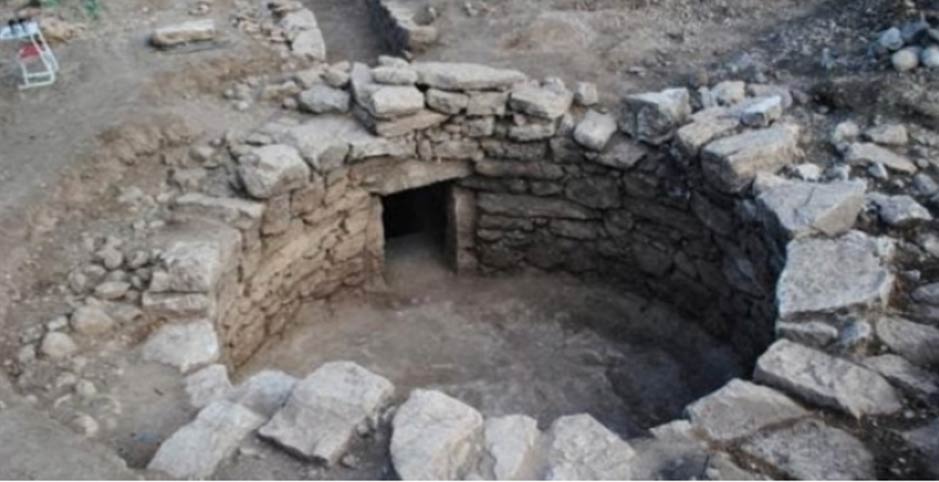3,300-year-old Mycenaean tomb and precious artifacts found in Central Greece
Archaeologists have announced the discovery of a vaulted Mycenaean tomb near Amfissa, central Greece, containing human remains and a hoard of treasures. The 3,300-year-old tomb is the first of its kind to be found in the region, and one of only a few that have been found untouched. The finding is expected to provide valuable information regarding the habitation, burial customs, and possessions of the Mycenaeans in the 2nd millennium BC.
According to the Greek Reporter, the ancient tomb was found during an irrigation project that required excavation in the area. A preliminary analysis of the monument revealed that grave robbers had tried to gain access to the interior of the tomb in the past, but had failed, allowing the precious grave goods to remain untouched over the millennia.
The tomb is a tholos, or beehive tomb, characterized by a vaulted ceiling created by the superposition of successively smaller rings of mudbricks or, more often, stones. In Greece, the vaulted tholoi are a monumental Late Bronze Age development. After about 1500 BCE, tholoi became more widespread and are found in every part of the Mycenaean heartland. They are typically cut into the slope of a hillside so that only the upper third of the vaulted chamber was above ground level. This masonry was then concealed with a relatively small mound of earth. After a burial, the entrance to the tomb was filled in with soil, leaving a small mound with most of the tomb underground. One of the finest examples is the Treasury of Atreus in Mycenae.

The Treasury of Atreus in Mycenae, Greece (public domain)
Lamiastar.gr reports that the newly-discovered tomb is 9 meters (30ft) long with a circular burial chamber measuring 5.9 meters (19ft) in diameter. The vaulted ceiling had collapsed but the walls of the chamber are well-preserved and maintained a height of almost 3 meters (10ft).
Within the burial chamber, archaeologists found a large number of human bones. The dead had been buried in the floor with their personal belongings until complete decomposition. Their bones had then been pushed near the walls of the tomb in order to create space for newer burials and a few of these were better preserved than the rest.
The research team, led by chief archaeologist Athanasia Psalti, unearthed many unique and valuable artifacts inside the tomb, including more than forty pieces of painted pottery, bronze vases, small vessels for storing aromatic oils, gold and bronze rings, one of which had an engraved decoration, buttons made of semi-precious stones, two bronze daggers, spearheads, female and zoomorphic idols and a large number of seals with animal, floral and linear motives.
An analysis of the artifacts and remains revealed that the tomb had been in use for more than two centuries, from 1300 BC to 1100 BC. The full scientific research regarding the finding will be made by a team of archaeologists shortly and is expected to provide new information about the archaeological and historical development of the region.
Video courtesy of Lamiastar.gr showing the newly-discovered tomb and artifacts
The Mycenaean civilization emerged in Greece around 1600 BC, when Helladic culture in mainland Greece was transformed under influences from Minoan Crete. It takes its name from the archaeological site of Mycenae in Argolis, Peloponnese, southern Greece. Unlike the Minoans, whose society benefited from trade, the Mycenaeans advanced through conquest and their civilization was dominated by a warrior aristocracy. Around 1400 BC, the Mycenaeans extended their control to Crete.

Fresco of a Mycenaean woman (public domain)
Around 1100 BC, the Mycenaean civilization perished with the collapse of Bronze-Age civilization in the eastern Mediterranean, which is commonly attributed to the Dorian invasion, although alternative theories propose natural disasters and climatic changes.
MORE:
- Did Mycenaean Greeks serve in the Egyptian military of Ramesses?
- Mycenae, the Ancient city founded by Perseus
- Climate Change may have Caused Collapse of Civilizations in Late Bronze Age
Featured image: Newly-discovered Mycenaean tomb near Amfissa, Greece.



















